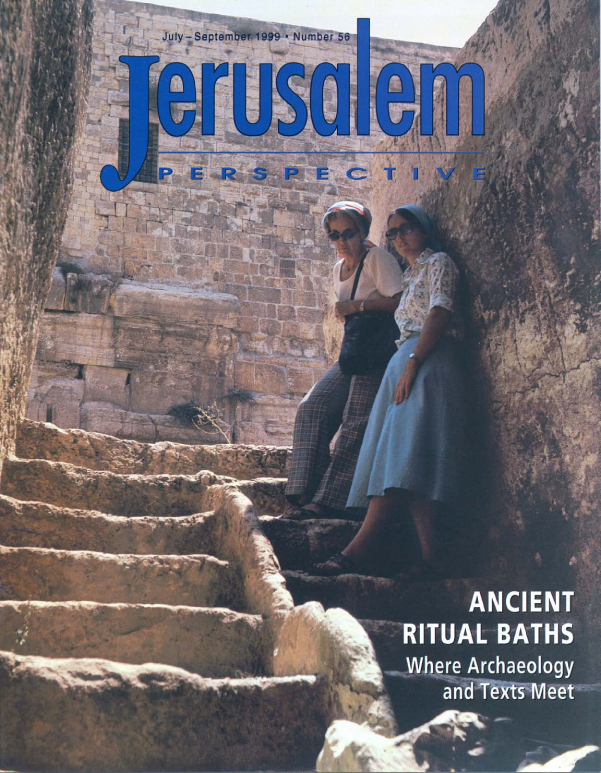How to cite this article: David N. Bivin, “The New International Jesus,” Jerusalem Perspective 56 (1999): 20-24 [https://www.jerusalemperspective.com/5197/].
Revised: 6 June 2023
The New Testament writer Luke described both Jesus and Paul as speaking in Hebrew (Acts 21:40; 22:2; 26:14). In all three places, however, translators of the New International Version rendered the Greek word Ἑβραΐς (Hebra’is) as “Aramaic.”[9] Liberties with the text require explanation, so they supplied these notes: “Or Hebrew” at 26:14, and “Or possibly Hebrew” at 21:40 and 22:2. To reflect more accurately the Greek, they would have done better to translate Hebra’is as “Hebrew.” If, then, concluding that such a translation might mislead the reader, they could have added a note expressing their concern, for example: “The Greek text literally reads ‘Hebrew,’ but many scholars think that most first-century Jews in the land of Israel spoke Aramaic; therefore, the reader should interpret ‘Hebrew’ to mean ‘Aramaic.’”[10]
| Rather listen instead? |
| JP members can click the link below for an audio version of this essay.[*]
Paid Content
Premium Members and Friends of JP must be signed in to view this content. If you are not a Premium Member or Friend, please consider registering. Prices start at $5/month if paid annually, with other options for monthly and quarterly and more: Sign Up For Premium  |
The NIV Study Bible does offer an explanation for the word “Aramaic” in Acts 21:40: “More likely Aramaic than Hebrew, since Aramaic was the most commonly used language among Palestinian Jews.” On the word “Aramaic” in Acts 22:2, it again comments: “Actually, if he [Paul] had spoken in Hebrew, they [the crowd] would have become quieter in order not to miss a single word, because it would have been more difficult for them to understand.”
This argument based on the crowd’s relative silence seems a bit forced. When Paul motioned with his hand to the people, there was “a great silence” (Acts 21:40). When he began to speak in the “Aramaic” language, they became quieter (Acts 22:2). Had he spoken in Hebrew, according to The NIV Study Bible commentator Lewis Foster, the people would have become even quieter. How can one know how much quieter than quiet the people could have become? A more natural explanation would be that the people settled down when Paul motioned to them, and they became silent the moment he began to speak.
The NIV translators also rendered the adverb Ἑβραϊστί (Hebra’isti) as “in Aramaic” in John 5:2; 19:13, 17, 20; and 20:16. The Johannine verses have no accompanying notes to indicate that the Greek adverb may mean simply “in Hebrew.”[11] Interestingly, however, they rendered Hebra’isti as “in Hebrew” in Revelation 9:11 and 16:16. Here the Greek allowed no other option, since Abaddon (9:11) and Harmagedon (16:16) can only be the transliterations of Hebrew and not Aramaic words.
Premium Members and Friends of JP must be signed in to view this content.
If you are not a Premium Member or Friend, please consider registering. Prices start at $5/month if paid annually, with other options for monthly and quarterly and more: Sign Up For Premium

| [*] Music in the Audio JP files is excerpted from the Hebrew song Moshe written by Immanuel Zamir in a recording sung by Yaffa Yarkoni obtained from Wikimedia Commons. |

- [1] Gustaf Dalman, The Words of Jesus (Edinburgh: T. & T. Clark, 1902), 11. The Words of Jesus is the authorized English version of Dalman's 1898 Die Worte Jesu. In fairness to Dalman and in respect for his great erudition, one should keep in mind that he wrote these words in the year that the Cairo Genizah was discovered, and long before the Dead Sea Scrolls came to light. ↩
- [2] According to Michael Wise, Martin Abegg, Jr. and Edward Cook, "Prior to the discovery of the Dead Sea Scrolls, the dominant view of the Semitic languages of Palestine in this period was essentially as follows: Hebrew had died; it was no longer learned at mother's knee. It was known only by the educated classes through study, just as educated medieval Europeans knew Latin...The spoken language of the Jews had in fact become Aramaic...The discovery of the scrolls swept these linguistic notions into the trash bin...Apart from copies of biblical books, about one out of six of the Dead Sea Scrolls is inscribed in Aramaic. Clearly the writing of an Aramaic Gospel was eminently possible. Yet the vast majority of the scrolls were Hebrew texts. Hebrew was manifestly the principal literary language for the Jews of this period. The new discoveries underlined the still living, breathing, even supple character of that language. A few texts pointed to the use of Hebrew for speech as well as writing...A small minority of the scrolls were written in Greek. Their discovery has vouchsafed us a further glimpse into the linguistic complexity of first-century Jewish society. Hebrew, Aramaic, Greek: each was being used in particular situations of speech and writing" (The Dead Sea Scrolls: A New Translation [New York: HarperCollins Publishers, 1996], 8-10).
For a survey of the linguistic situation in first-century Israel, see Shmuel Safrai, "Spoken Languages in the Time of Jesus," Jerusalem Perspective 30 (Jan./Feb. 1991): 3-8, 13; and Safrai, "Literary Languages in the Time of Jesus," Jerusalem Perspective 31 (Mar./Apr. 1991): 3-8. James Barr has rightly criticized New Testament scholarship for continuing to function under the outdated and mistaken notion that Hebrew was not spoken in the first century ("Hebrew, Aramaic and Greek in the Hellenistic Age," The Cambridge History of Judaism: The Hellenistic Age [Cambridge: Cambridge University Press, 1989], 79-114). ↩
- [3] Even when Josephus wrote that he himself was a Hebrew speaker, scholars interpreted this to mean Aramaic. Like Paul, Josephus once addressed a crowd in Jerusalem during a time of great commotion (War 6:96). H. St. J. Thackeray's translation and note to War 6:96 illustrate the scholarly bias that often still exists regarding the linguistic situation in first-century Israel: "Josephus, standing so that his words might reach the ears not only of John but also of the multitude, delivered Caesar's message in Hebrew...." (The Loeb Classical Library: Josephus [London: William Heinemann Ltd., and Cambridge, MA: Harvard University Press, 1961], 3: 403). On the word "Hebrew," Thackeray commented: "I.e., Aramaic; cf. Acts 21:40, 22:2." He cited the passages from Acts as if they support his assertion that when Josephus mentioned Hebrew, he meant Aramaic. These New Testament passages are no support at all, since they, too, mention Hebrew, not Aramaic. ↩
- [4] A Greek-English Lexicon of the New Testament and Other Early Christian Literature, trans. and ed. William F. Arndt and F. Wilbur Gingrich (Chicago: University of Chicago Press; and Cambridge: Cambridge University Press, 1957), 212. ↩
- [5] Jehoshua M. Grintz, “Hebrew as the Spoken and Written Language in the Last Days of the Second Temple,” Journal of Biblical Literature 79 (1960): 32-47. Grintz stated: "An investigation into the writings of Josephus demonstrates beyond doubt that whenever Josephus mentions glotta Hebraion [Hebrew tongue], Hebraion dialekton [Hebrew dialect], etc., he always means 'Hebrew' and no other language" (p. 42). To support this statement, Grintz quoted Josephus (Antiq. 1:33): "For which reason we also pass this day in repose from toil and call it the Sabbath [Sabbata], a word which in the Hebrew language [Hebraion dialekton] means 'rest'" (p. 42). Grintz commented: "Josephus derives, as had the Bible, the word Sabbath from the Hebrew shavath. In Aramaic the verb shavath does not exist. Aramaic translators use instead nah" (pp. 42-43). Another example from Josephus (Antiq. 1:34) that Grintz provided is: "Now this man was called Adam which in Hebrew [glotta Hebraion] signifies 'red'" (p. 43). Grintz commented: "Thus Josephus derives adam [man] from adom, 'red.' In Aramaic 'red' is expressed by sumka; there is no root '-d-m in this language" (p. 43). Grintz emphasized that while it is true that Josephus in his writings referred to Aramaic, he "never said of any of the words cited in their Aramaic form that they were Hebrew" (p. 45). ↩
- [6] The same Greek phrase, to kraspedon tou himatiou autou (the tassel of his outer robe), appears in Matt. 14:36 and its parallel, Mark 6:56. Here, too, the NIV renders the phrase “the edge of his cloak.” ↩
- [7] The New International Version stands out in contrast to a majority of English versions, further evidence of tendentiousness. When translating Matt. 23:5 and Matt. 9:20, few English versions have made a distinction between Jesus’ Jewish observance and that of his countrymen. I have checked the twenty-eight versions listed in footnote 4. For the seven versions that, like the NIV, did make a distinction, see the following comparison.
Seven Tassel-free-Jesus Translations
Bible Translation Matthew 9:20 Matthew 23:5 The Four Gospels: A New Translation
(Charles Cutler Torrey)“the hem of his garment” “their fringes” The New Testament in Modern English
(J.B. Phillips)“the edge of his cloak” “the tassels of their robes” The Holy Bible: New Century Version “the edge of his coat” “their special prayer clothes” The Message: The New Testament, Psalms and Proverbs
(Eugene H. Peterson)“his robe”
[Mt. 14:36—“the edge of his coat”]“embroidered prayer shawls” Good News Bible “the edge of his cloak” “the tassels on their cloaks” The New English Bible “the edge of his cloak” “[go about…with large] tassels on their robes” Jesus: The four Gospels, Matthew, Mark, Luke and John, combined in one narrative and rendered in modern English
(Charles B. Templeton)“she reached out and touched him”
[Mt. 14:36—“the hem of your robe”]“[How they love] the [longest possible] tassels on the corners of their robes” - Charles Cutler Torrey's The Four Gospels: A New Translation was published by Hodder & Stoughton in 1934.
- J. B. Phillips' The New Testament in Modern English was published by The Macmillan Company in 1958.
- The Holy Bible: New Century Version was published by Word Publishing in 1987.
- Eugene H. Peterson's The Message: The New Testament, Psalms and Proverbs was published by NavPress in 1993.
- The Good News Bible: Today's English Version was published by Thomas Nelson in 1976.
- The New English Bible was published jointly by Oxford University Press and Cambridge University Press in 1961.
- Charles B. Templeton's Jesus: The four Gospels, Matthew, Mark, Luke and John, combined in one narrative and rendered in modern English was published by Simon and Schuster in 1973.
- [8] See David Bivin, "The Hem of His Garment," Jerusalem Perspective 7 (April 1988): 2. ↩
- [9] The New International Version is copyrighted by the International Bible Society and published by Zondervan Bible Publishers. ↩
- [10] A number of versions have marginal notes explaining that “Hebrew” refers to “Aramaic” (e.g., New American Standard: “Jewish Aramaic”; New Berkeley Version: “The language was the colloquial Aramaic that was used by the Jews of that period” [Acts 21:40]), but very rarely have Bible translators inserted the word “Aramaic” into the text. ↩
- [11] With three exceptions (note the following paragraphs), none of the major English versions, beginning with the Authorized Version of 1611, has rendered Hebra’is and Hebra’isti in John 5:2; 19:13, 17, 20; 20:16; Acts 21:40; 22:2 and 26:14 as “Aramaic” and “in Aramaic.” The New International Version stands out in this respect. The following twenty-eight versions have rendered Hebra’is and Hebra’isti as “(in) Hebrew,” “(in) the Hebrew tongue,” “(in) the Hebrew language,” and “(in) the Hebrew dialect”: Authorized Version (King James Version); American Standard Version; Revised Standard Version; New King James Version; New American Standard Bible; New Revised Standard Version; The New English Bible; The Jerusalem Bible; New Jerusalem Bible; The Modern Language Bible: The New Berkeley Version in Modern English; The Bible: An American Translation (NT: Goodspeed); The New American Bible; The Bible: A New Translation (Moffatt); The Amplified Bible; The Living Bible (Taylor); The Holy Bible: New Century Version; The New Testament in Modern English (Phillips); The New Testament in Modern Speech (Weymouth); Good News for Modern Man (Bratcher); Good News Bible; The Message: The New Testament, Psalms and Proverbs (Peterson); The New Testament: A Private Translation in the Language of the People (C. B. Williams); The New Testament: A New Translation in Plain English (C. K. Williams); The Simple English Bible: New Testament; The New Testament: A New Translation (Barclay); Jewish New Testament (Stern); Jesus: The four Gospels, Matthew, Mark, Luke and John, combined in one narrative and rendered in modern English (Templeton); The Four Gospels: A New Translation (Torrey).
One version’s skewed handling of Acts 21:40, 22:2 and 26:14 is even more pronounced than the NIV’s: The New Living Translation, published jointly by the International Bible Society and Tyndale House Publishers in 1996, rendered Acts 21:40 as “in their own language, Aramaic,” with the note: “Or Hebrew.” It rendered Acts 26:14 as “in Aramaic,” with the note: “Or Hebrew.” It rendered Acts 22:2 as “in their own language,” with the note: “Greek in Aramaic.” This note renders the NLT’s readers a disservice since the Greek text does not say “in Aramaic,” but rather, “in Hebrew”!
The Simple English Bible: New Testament (American edition), whose English vocabulary includes only 3,000 words, was published by the International Bible Translators in 1981. Except for Rev. 9:11 and 16:16 (“in Hebrew”; “in the Hebrew language”), the SEB rendered the occurrences of Hebra’is and Hebra’isti in the New Testament as “(in) the Aramaic language” or “in Aramaic” (John 5:2; 19:13, 17, 20; 20:16; Acts 21:40; 22:2; 26:14). Only in two of these eight instances (Acts 22:2; 26:14) was a note of justification provided. To the translation “in Aramaic” in Acts 22:2, this note was appended: “the native language of the Jews.” To the translation “in the Aramaic language” in Acts 26:14, this note was added: “The Jews had a special reverence for their native language.”
A third case of translation that runs counter to the Greek text is found in David H. Stern’s Jewish New Testament (1989). Stern, who usually rendered Hebra’is and Hebra’isti as “(in) Hebrew,” three times translated these words “in Aramaic” (John 5:2; 19:13, 17). It is unusual that in these instances he did not feel the need to justify his rendition with a note informing the reader that the Greek reads “in Hebrew.” The reader has been left to believe that in these places the Greek text actually reads Sūristi (in Aramaic). ↩




